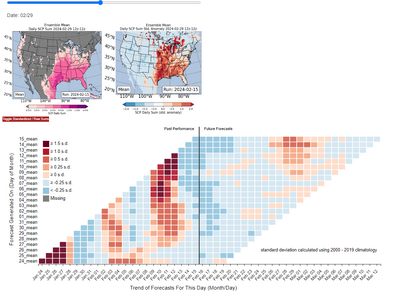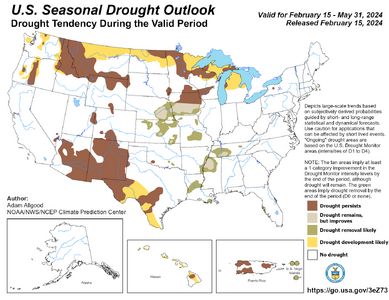I use this site for soil RH content.
Real-time 3km Land Information System over the SE U.S.
There are options for comparing 1-week, 2, etc., to one year, which can suggest a trend. I have found over the last 37 years of chasing extensively in the western areas (E-NM, E-C0, W-K, W-TX), that higher, seasonal RH content does play a role preventing the dryline from mixing further east if everything else goes right, especially w/ surface winds. There is also a correlation between soil RH and climatology as higher levels sometimes means there is a more active pattern, but I've seen high RH soil years go bust. For me, higher soil RH also means less dust, which can kill chasing near the DL.
The physics behind that are as follows:
The Southern Great Plains (SGP) dryline moves almost entirely due to vertical mixing rather than due to advection of dry air. That means vertical mixing is the key ingredient. Essentially we're talking PBL mixing. PBL mixing is, to a first order, driven by sensible heat flux (SH) at the land surface. As long as SH > 0 is true (i.e., during most of the daylight), the PBL can continue to mix and grow in depth. The vertical mixing of moisture within the PBL thus dictates how the DL will move. If the pre-existing moisture content is more shallow (typically the case at higher elevations), the mixing will "wipe out" the moisture in the area more quickly, and thus the DL will re-emerge at the edge of wherever the moisture was deeper and/or richer, which is almost always to the east/southeast in the SGP region.
The critical factor thus is the SH. SH doesn't come from nowhere - it comes out of a partitioning of the total available energy at the ground surface that responds to the classic 4-term equation: Rnet = SWdown + LWdown - (SWup + LWup). The minus sign is used to indicate direction (downward vs. upward). SW = "shortave" and refers to components directly from the sun, i.e., insolation and albedo effects. LW = "longwave" and reflects the transformation of the sun's (primarily) UV light into infrared by the Earth's surface. "SWdown" is more easily predictable since it depends on latitude and time of year, but later modified by cloud cover. "SWup" is generally a fixed fraction of SW down (again, albedo). "LWup" is just the Stefan-Boltzman Law for the ground, in which emitted LW energy is dependent on the 4th power of the radiative temperature (also referred to as skin temperature and the value of an IR satellite product pixel when there are no clouds). "LWdown" is a heat source for the ground dependent on the actual gaseous constituency of the atmospheric column over the ground - air has mass and emits energy, too. Some of that gets back to the ground. It's harder to precisely calculate this value, but field campaigns and model parameterizations suggest it is much smaller than the other components, so a big error in this term doesn't necessarily spell disaster when examining the surface energy budget.
Anyway, the net energy surplus or deficit, Rnet, is subsequently partitioned into three terms: Rnet = SH + LH + GH. LH = latent heat flux, which is the relevant term here. GH = ground heat flux and refers to energy that moves deeper below ground. This process can be small, but that doesn't mean it is isn't important. However, it is more complicated and I'm not going to delve into it. The key for this discussion is LH.
When the ground/soil is very wet, LH is going to be higher relative to SH (a term called the "Bowen ratio" = SH/LH, measures this). Since LH vs. SH vs. GH is a zero-sum game (actually, they sum to Rnet, but you get the idea), then if any one of these increases, the sum of the other two must decrease. Increased LH probably means SH is going to have to go down since GH has "less room to move" (if we could get soil temps to change rapidly, then this wouldn't be the case, but that's not how soil is constructed on Earth). Thus, taking the path of least resistance, we typically end up with less PBL mixing/shallower PBL, which will likely resist DL movement.
So yeah, that's how higher SGP moisture tends to mean further-west drylines.



